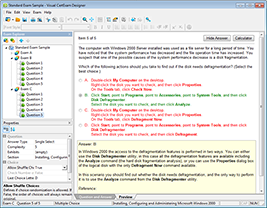IP Addressing
One of the most important topics in any discussion of TCP/IP is IP addressing. An IP address is a numeric identifier assigned to each machine on an IP network. It designates the specific location of a device on the network.
An IP address is a software address, not a hardware address—the latter is hard-coded on a network interface card (NIC) and used for finding hosts on a local network. IP addressing was designed to allow hosts on one network to communicate with a host on a different network regardless of the type of LANs the hosts are participating in.
Before we get into the more complicated aspects of IP addressing, you need to understand some of the basics. First I’m going to explain some of the fundamentals of IP addressing and its terminology. Then you’ll learn about the hierarc hical IP addressing scheme and private IP addresses.
IP Terminology
Throughout this chapter you’re being introduced to several important terms that are vital to understanding the Internet Protocol. Here are a few to get you started:
Bit A bit is one digit, either a 1 or a 0.
Byte A byte is 7 or 8 bits, depending on whether parity is used. For the rest of this chapter, always assume a byte is 8 bits.
Octet An octet, made up of 8 bits, is just an ordinary 8-bit binary number. In this chapter, the terms byte and octet are completely interchangeable.
Network address This is the designation used in routing to send packets to a remote network—for example, 10.0.0.0, 172.16.0.0, and 192.168.10.0.
Broadcast address The address used by applications and hosts to send information to all nodes on a network is called the broadcast
—gives you 2
32


 address. Examples of layer 3 broadcasts include 255.255.255.255, which is any network, all nodes; 172.16.255.255, which is all subnets
address. Examples of layer 3 broadcasts include 255.255.255.255, which is any network, all nodes; 172.16.255.255, which is all subnets
and hosts on network 172.16.0.0; and 10.255.255.255, which broadcasts to all subnets and hosts on network 10.0.0.0.
The Hierarchical IP Addressing Scheme
An IP address consists of 32 bits of information. These bits are divided into four sections, referred to as octets or bytes, with each containing 1 byte (8 bits). You can depict an IP address using one of three methods:
Dotted-decimal, as in 172.16.30.56
Binary, as in 10101100.00010000.00011110.00111000
Hexadecimal, as in AC.10.1E.38
All these examples represent the same IP address. Pertaining to IP addressing, hexadecimal isn’t used as often as dotted-decimal or binary, but you still might find an IP address stored in hexadecimal in some programs.
The 32-bit IP address is a structured or hierarchical address, as opposed to a flat or nonhierarchical address. Although either type of addressing scheme could have been used, hierarchical addressing was chosen for a good reason. The advantage of this scheme is that it can handle a large number of addresses, namely 4.3 billion (a 32-bit address space with two possible values for each position—either 0 or 1
, or 4,294,967,296). The disadvantage of the flat addressing scheme, and the reason it’s not used for IP addressing, relates to routing. If every address were unique, all routers on t he Internet would need to store the address of each and every machine on the Internet. This would make efficient routing impossible, even if
only a fraction of the possible addresses were used!
The solution to this problem is to use a two- or three-level hierarchical addressing scheme that is structured by network and host or by network, subnet, and host.
This two- or three-level scheme can also be compared to a telephone number. The first section, the area code, designates a very large area.
The second section, the prefix, narrows the scope to a local calling area. The final segment, the customer number, zooms in on thespecific connection. IP addresses use the same type of layered structure. Rather than all 32 bits being treated as a unique identifier, as in flat addressing, a part of the address is designated as the network address and the other part is designated as either the subnet and host or just the node address.
Next, we’ll cover IP network addressing and the different classes of address we can use to address our networks.



